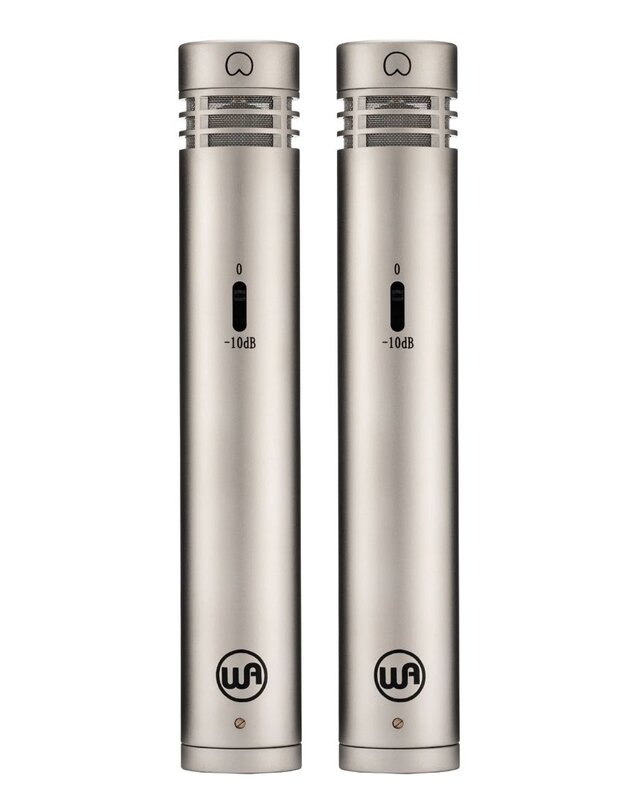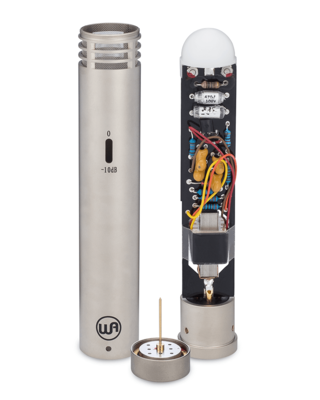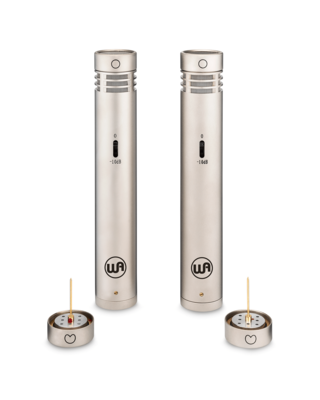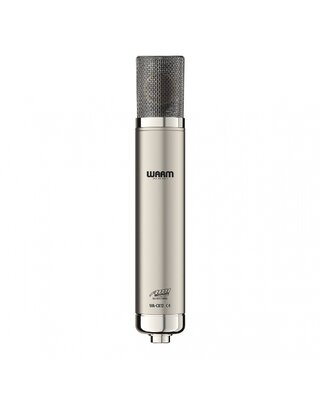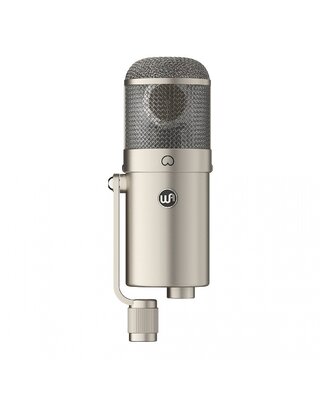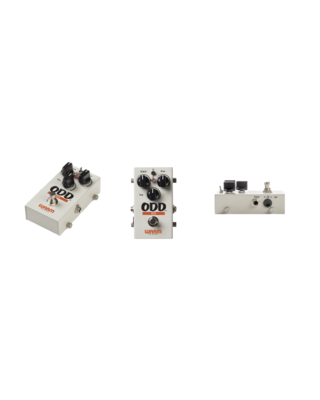Warm Audio has had quite a bit of success creating “tributes” to classic audio products, including microphones, preamps and compressors. The company’s ability to capture the spirit of these products, manufacture them using modern production techniques, and sell them at reasonable prices is an attractive formula for engineers and studios seeking to recreate the vibe of vintage gear while not breaking the bank.
It is with that intention that Warm Audio has introduced the WA-84. Based upon the wonderful, German-made KM84, the WA-84 is a small-diaphragm cardioid condenser microphone featuring discrete Class-A circuitry and high-quality components in the audio path. A custom-made capsule spec’d by Warm and manufactured in Australia was designed to reproduce the sound of the original capsule, and the output is coupled using a nickel-core CineMag transformer. Warm’s decision to use an output transformer is a nod to the original design and is an important ingredient to the sonic character of both mics.
A BRIEF HISTORY LESSON
The original KM84 was introduced in 1966 and was the first microphone to employ phantom power. One of its strengths is a classic cardioid pattern with extremely smooth off-axis response. Sounds reaching the capsule from the sides exhibit a very similar frequency response and lack of color when compared to on-axis pickup. The KM84 was discontinued in 1992 and eventually replaced with the KM184, which utilizes the same capsule but is otherwise a different animal.
The WA-84 is available in nickel or black finishes and looks very similar to the KM84. It has the same distinctive side ports and a similar profile, though the WA-84 is slightly fatter and about an inch longer than the KM84.
Like the vast majority of KM84s, the WA-84 has a -10 dB pad switch, though it is different in design from the original. Also like the original, the WA-84’s capsule can be removed, which makes me wonder if Warm Audio has an omni capsule planned for the future. Its frequency response differs from that of the KM84, reaching down to 20 Hz, as opposed to 40 Hz, and the WA-84 has a gentle bump of about 2.5 dB in the region of 15 kHz. The WA-84 runs on 48-volt phantom power.
Warm sent Mix a stereo pair of WA-84s for this review. The set is packaged in a foam-lined, hard plastic case with compartments for the mics, windscreens, hard mounts and shock mounts, all of which are included. The manual provides some useful information regarding cables, pop filters and using a pair of WA-84s in spaced pair and XY stereo configurations.
LINE ‘EM UP
I’m lucky enough to own three original KM84s: a pair with consecutive serial numbers that look like they just exited the factory, and a single that’s not quite as nice cosmetically but sounds equally good. I’ve used these mics for drum overheads, acoustic guitar, piano, percussion, voice and occasionally on snare drum—but only if I really trust the player! I also have access to multiple pairs of KM184s, so it was only natural to do an A/B/C comparison between the mics.
Mercy College Music Studios Manager Sam Stauff and I set up spaced pairs of WA-84s, KM84s and KM184s overhead a Ludwig Legacy Mahogany Series drum kit with Zildjian K Custom Dark cymbals in Mercy Studio A. Sweet.
All of the microphones were routed through a Focusrite ISA828 preamp for fair comparison, and recorded into Pro Tools HD. Gain on the ISA828 was set the same for all of the mics; in general, output levels from the WA-84s and KM84s were within a few dB, while output from the KM184s was a bit hotter than the other two.
The results were interesting. The WA-84s and KM84s sounded very similar. The KMs had a smoother top end, but less whump in the lower frequencies than the WA-84s—probably due to the WA-84’s ability to reach down to 20 Hz.
Midrange from the KMs was beautiful, and though the WAs were close, they didn’t produce that grind you can get when the KM transformer saturates. Snare drum was more focused and imaging was better with the WA-84s than the KM84s, which speaks to the matching of the two WA-84s. The transformerless KM184s were quite different from the others, as expected. They were the brightest of the bunch, but kinda vanilla—though I might prefer that for certain applications. In terms of brightness, the WA-84s fell in between the KM84s and KM184s.
We then compared the three mics on a vintage Gibson J-45 acoustic guitar, this time using an API 3124V (4-channel) preamp. In this application it was difficult to tell the mics apart. Low-mids were a hair more emphasized by the WA-84, but if you switched tracks when someone walked out of the room, they probably wouldn’t notice the difference when they returned. The KM184 was a little bit thinner, brighter and quieter than the other two mics—though noise was really not an issue with any of the microphones. For fingerpicked acoustic guitar, the KM184s produced more presence, but when the guitar was played with a pick we preferred the WA-84 and KM84.
Back at my studio, I put the WA-84s and KM84s through more A/B comparisons, first close-miking a Ludwig Supraphonic snare drum from the late 1970s. I used a Grace 201 preamp, not because it’d be my first choice for use on a snare but because it’s very transparent and I wanted to hear differences in the microphones as clearly as possible.
The KM84 generated that nice midrange saturation and an extended top end, while the WA-84 was more polite, well-controlled and tighter-sounding—which I preferred to the sound of the KM84. Hi-hat leakage was more noticeable in the KM than it was in the WA.
When used to record a strummed acoustic guitar with the Grace pre, the bottom end extension of the WA-84 easily revealed the sound of the player tapping his foot on the floor, whereas the KM84 did not.
The KM84 had more breath on a male vocal while the WA-84 yielded more thickness, giving it some “larger-than-life” character (almost like proximity effect), but again, they were difficult to tell apart. This lower-mid character is a plus when using the mics for drum overheads, as it adds impact and presence to the toms. Imaging of the WA-84s arranged in an ORTF stereo array was excellent: the ride, hat and crash cymbals were positioned exactly where they should have been.
One of the attributes of the KM84 is its ability to capture off-axis sound without adding color, and the WA-84 shares that trait. Sounds coming at the WA-84 from 90 degrees off-axis pretty much sounded the same as they would at 0 degrees, save for a little “air” at the top and a slight reduction in low end.
I then used both microphones to record a variety of percussion instruments, including glockenspiel, wood blocks, shakers and tambourines. Full disclosure: I prefer ribbon microphones for percussion, but the WA-84 and KM84 sounded very good in this application. The WA-84’s high-frequency response produced more definition on the leading edge of attack, but not obnoxiously so.
One minor gripe I have with the WA-84 is the pad switch, which requires a small screwdriver or paper clip to access; I suppose that also means that it can’t be changed by accident. It’s worth noting that the KM84’s pad switch was also a pain in the arse and could be damaged if one wasn’t careful.
Purchasing a pair of original KM84s will set you back anywhere from $2,000 to $4,000 depending upon condition, and you may be rolling the dice on whether they’ve been used, abused or modified. A pair of Warm Audio WA-84s cost a fraction of that amount and sound very close to the originals.
The WA-84’s accessories are kind of generic—you don’t get the sexy packaging that you would expect with a high-priced mic—but the mic definitely captures the spirit of the KM84, and you can place it on a snare drum without having a heart attack. If you’re looking for the KM84 sound but are hesitant to commit that kind of investment, the WA-84 would be an excellent alternative.





